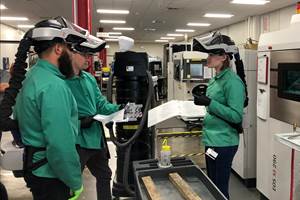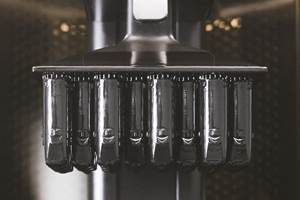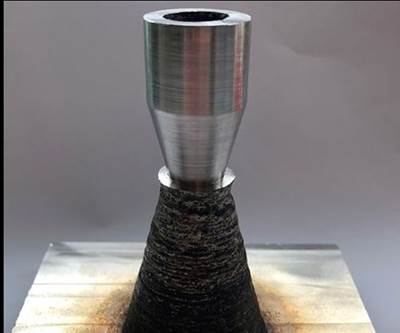AM 101: Hybrid Manufacturing
Additive manufacturing offers powerful capabilities alone, but even more opportunities are opened when AM is combined with subtractive processes.
Share

Hybrid manufacturing combines subtractive processes with 3D printing. The blade tips of this impeller were added to the machined part using an additive manufacturing head. Photo Credit: Hybrid Manufacturing Technologies
What Is Hybrid Manufacturing?
While “hybrid” can be used to describe many combinations of subtractive and additive manufacturing (AM), “hybrid manufacturing” most often refers to the combination of machining and 3D printing, typically metal.
Hybrid systems most often consist of a machine tool such as a mill or lathe, or a robot arm, that is equipped with a directed energy deposition (DED) head for depositing metal powder or wire. Other systems are available that combine machining with powder-bed fusion (PBF). There are also hybrid systems for processing polymers, typically using material extrusion as the additive process.
Manufacturing a component combining powder-fed DED and machining.
Video: DMG MORI, gif made via GIPHY
How Does Hybrid Manufacturing Work?
One of the most common methods of hybrid manufacturing is to apply additive and subtractive processes in sequence. For example, the machine could 3D print a near-net shape component that takes the place of a conventional casting or forging. Then, its subtractive capabilities could be applied to finish this part.

This scaled-down turbine casing made on DMG MORI’s Lasertec 65 3D was built up from Inconel 718 and bronze, and then machined only where necessary.
It is also typically possible to alternate between additive and subtractive in-process. For instance, the system could machine a blank, 3D print needed features onto the part, and then machine those 3D printed features. Or, machining could be applied to finish internal features as they are printed.
What Materials Can Be Used?
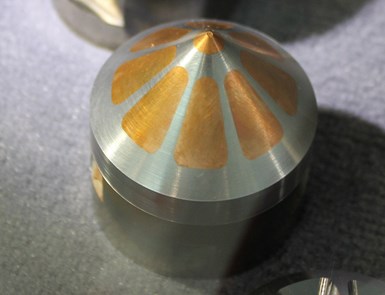
With hybrid manufacturing it is often possible to combine materials. This component 3D printed using Hermle’s Metal Powder Application (MPA) process and then machined is steel with embedded copper to transport thermal energy.
Depending on the system, nearly any metal available in a wire or powder format could be 3D printed. These include aluminum, cobalt chrome, copper, Inconel, stainless steel, tool steel and titanium, among others. One advantage of hybrid metal systems is that they often enable applying dissimilar metals to the same part, for instance cladding with Inconel for strength or incorporating copper for heat transfer.
Polymer systems often use fused filament fabrication (FFF) and so many different polymer filaments can be applied. There are also large-scale hybrid systems that use injection molding pellets and may be compatible with composite reinforced polymers. Hybrid polymer systems can also apply multiple materials, for instance to create an overmolding effect.

The Large Scale Additive Manufacturing (LSAM) hybrid from Thermwood combines 3D printing with injection molding pellets with five-axis machining capability on a large scale, enabling printing and finishing parts such as this boat hull mold, in one setup. Photo Credit: Thermwood
Why Use Hybrid Manufacturing?
Hybrid manufacturing offers a number of benefits over machining or 3D printing alone. Because of additive’s ability to add material to existing parts, it is possible to build up and repair damaged parts, or to reduce machining work by starting with a smaller blank and adding material just where it is needed. 3D printing also allows for the use of multiple materials in a single part, which makes it possible to clad weaker metals for greater strength, add copper to aid heat transfer or save money on material by applying expensive metals only where they are needed.
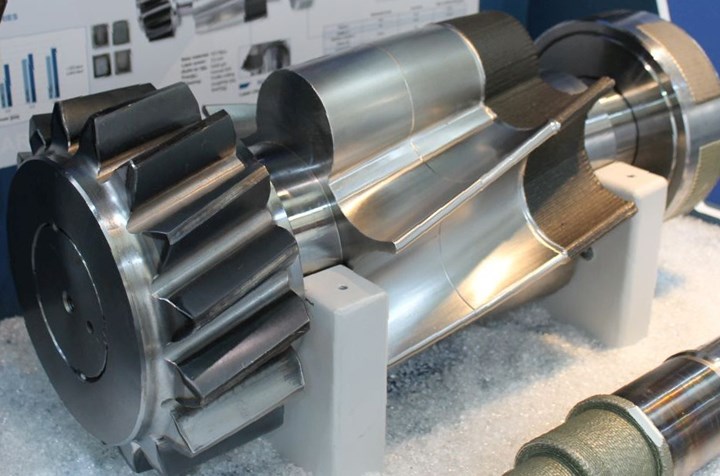
In lieu of manufacturing this entire rotor body from an expensive material, hybrid manufacturing made it possible to apply Inconel 625 just to the portions that require wear and heat resistance. The rest of the part is machined from steel.
When additive is combined with machining in a hybrid system, it is possible to 3D print and finish a part in a single setup. This approach reduces error because the printed part does not have to leave the build envelope and be reset on a separate machine. It is also possible to alternate printing and machining to finish internal features, such as conformal cooling channels for injection molds, or features that would be inaccessible in the completed part.
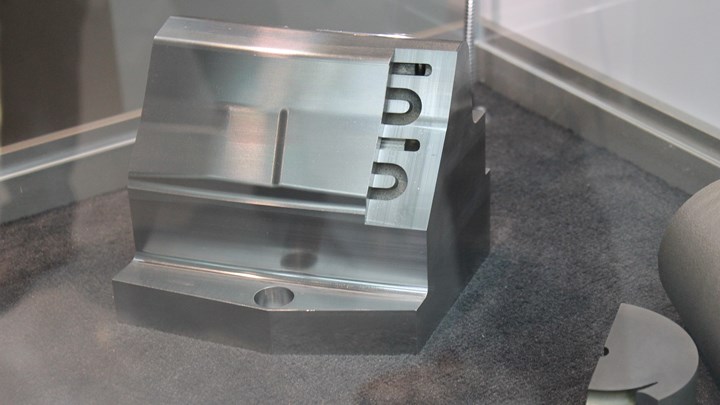
This mold core features a cooling channel milled into a blank; additional material was then 3D printed over this feature to enclose the channel.
Ready to learn more?
Explore the Hybrid Manufacturing zone.
Related Content
How to Pursue a Career in Additive Manufacturing
AM professionals are in demand as 3D printing matures and advances. But what skills are hiring manufacturers looking for? How can applicants prepare? And where can you find relevant job listings?
Read MoreHow Siemens Energy Applies Additive Manufacturing for Power Generation and More
At an applications center in Orlando, Florida, a small team of AM specialists is spanning industries by 3D printing parts to support both Siemens Energy power generation systems and external customers.
Read MoreAM 101: Digital Light Synthesis (DLS)
Digital Light Synthesis (DLS) is the name for Carbon's resin-based 3D printing process. How it works and how it differs from stereolithography.
Read MoreAM 101: What Is Binder Jetting? (Includes Video)
Binder jetting requires no support structures, is accurate and repeatable, and is said to eliminate dimensional distortion problems common in some high-heat 3D technologies. Here is a look at how binder jetting works and its benefits for additive manufacturing.
Read MoreRead Next
Okuma Engineer Offers Safety Tips for Hybrid Machine Tools
Shop air should be out of reach, but flood coolant is a friend, he says. The real challenge of hybrid machines right now is not safety procedures but software.
Read MoreAM 101: What Is Binder Jetting? (Includes Video)
Binder jetting requires no support structures, is accurate and repeatable, and is said to eliminate dimensional distortion problems common in some high-heat 3D technologies. Here is a look at how binder jetting works and its benefits for additive manufacturing.
Read MoreCombining Additive and Subtractive Processes for Hybrid Machining
At this point, we are still learning how to combine the two to optimize hybrid manufacturing.
Read More
.jpg;width=70;height=70;mode=crop)

